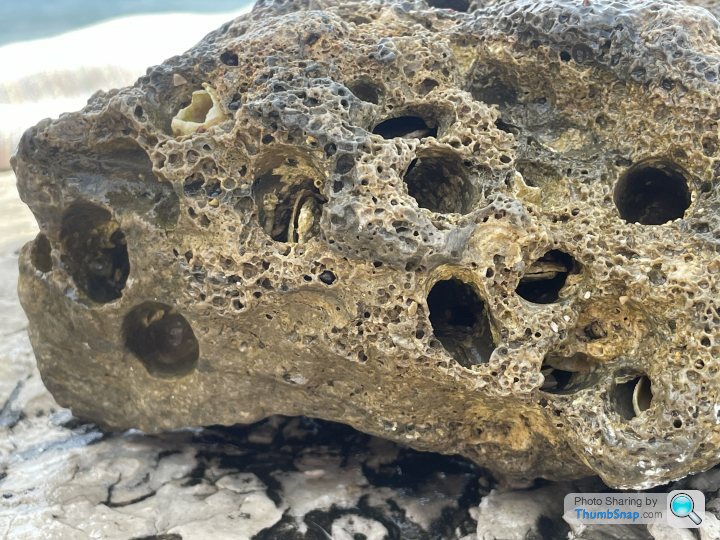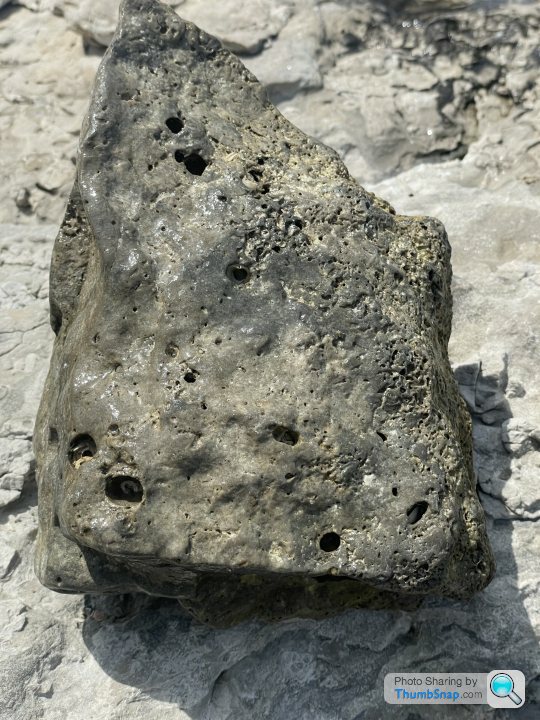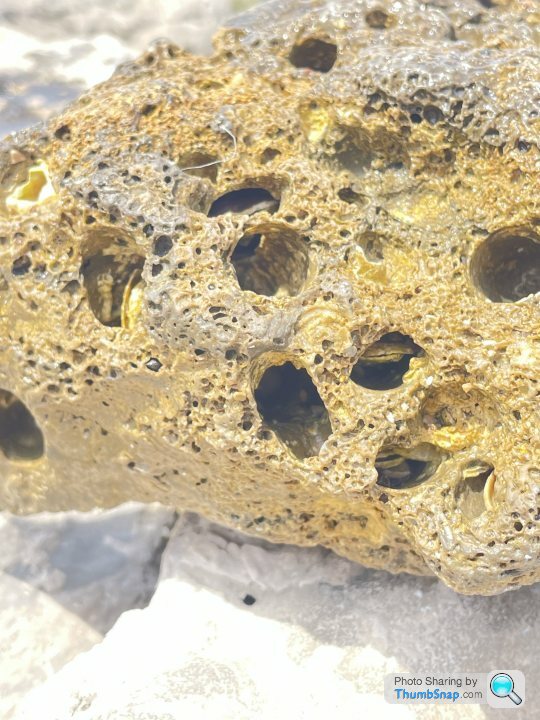Any Geologists on here? Unusual rock
Discussion
Came across this odd rock in the sea today, it looks as if it should be light like pumis but it's as heavy as granite.

It looks volcanic but what would cause the smooth tubes to form, the other side was smooth as if a different rock.

It was a bit bigger than the palm of my hand but weighed 4/5 kilo.

I over exposed that one to see the small clam like shellfish that had out grown their homes.

It looks volcanic but what would cause the smooth tubes to form, the other side was smooth as if a different rock.

It was a bit bigger than the palm of my hand but weighed 4/5 kilo.

I over exposed that one to see the small clam like shellfish that had out grown their homes.
tight fart said:
From asking elsewhere they say, "Fission tube worm rock with piddock clams."
Trying to find out what a 'fission tube' was, I found:https://seagrant.oregonstate.edu/sites/seagrant.or...
I can't remember the name of the creatures, (my Italian colleague advises they are called date del mare, sea dates or date muscles) but there are a type of muscle in North West Italy that bores those bigger holes in the rocks all along the coast.
They used to be eaten, until their numbers started declining and i believe now your not allowed to harvest or eat them.
They used to be eaten, until their numbers started declining and i believe now your not allowed to harvest or eat them.
rolster said:
I can't remember the name of the creatures, (my Italian colleague advises they are called date del mare, sea dates or date muscles) but there are a type of muscle in North West Italy that bores those bigger holes in the rocks all along the coast.
They used to be eaten, until their numbers started declining and i believe now your not allowed to harvest or eat them.
https://www.facarospauls.com/apps/italian-food-dec...They used to be eaten, until their numbers started declining and i believe now your not allowed to harvest or eat them.
Lithophaga lithophaga, which obviously translates to "stone eater".
https://www.sciencedirect.com/science/article/pii/...
In Oliths lower link above the boring mecanisum is described as:-
Quote
Lithophaga lithophaga generally inhabits galleries bored in limestones, by attaching its antero-ventral shell margin to the inner wall of the holes with byssus (Owada, 2007). The absence of erosion marks on the shell of this species excludes any mechanical excavation; galleries are dug with a neutral mucoprotein with calcium-binding ability, which is secreted by pallial glands (Jaccarini et al., 1968). Cavities are typically 1.5 times greater than the individual that excavated it (Galinou-Mitsoudi and Sinis, 1995), and tend to be perpendicular to the rocky surface, in order to minimize the intraspecific competition (Guallart and Templado, 2012). Date mussel boring activity occurs mainly in the autumn-winter season, since during the rest of the year most of the energy is spent for reproduction (Galinou-Mitsoudi and Sinis,
Unquote
To condense that down a bit, its secretions disolve the rock slowly over time during non reproduction times of the year.
Quote
Lithophaga lithophaga generally inhabits galleries bored in limestones, by attaching its antero-ventral shell margin to the inner wall of the holes with byssus (Owada, 2007). The absence of erosion marks on the shell of this species excludes any mechanical excavation; galleries are dug with a neutral mucoprotein with calcium-binding ability, which is secreted by pallial glands (Jaccarini et al., 1968). Cavities are typically 1.5 times greater than the individual that excavated it (Galinou-Mitsoudi and Sinis, 1995), and tend to be perpendicular to the rocky surface, in order to minimize the intraspecific competition (Guallart and Templado, 2012). Date mussel boring activity occurs mainly in the autumn-winter season, since during the rest of the year most of the energy is spent for reproduction (Galinou-Mitsoudi and Sinis,
Unquote
To condense that down a bit, its secretions disolve the rock slowly over time during non reproduction times of the year.
Gassing Station | Science! | Top of Page | What's New | My Stuff



